Related Research Articles

Louis XVIII, known as the Desired, was King of France from 1814 to 1824, except for a brief interruption during the Hundred Days in 1815. He spent twenty-three years in exile: during the French Revolution and the First French Empire (1804–1814), and during the Hundred Days.
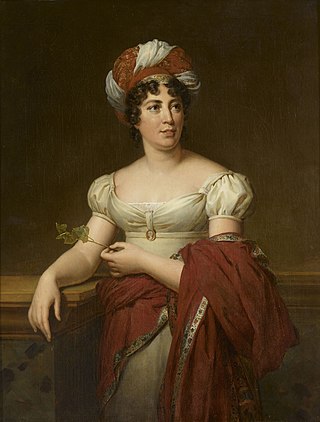
Anne Louise Germaine de Staël-Holstein, commonly known as Madame de Staël, was a French woman of letters and political theorist, the daughter of banker and French finance minister Jacques Necker and Suzanne Curchod, a leading salonnière. She was a voice of moderation in the French Revolution and the Napoleonic era up to the French Restoration. She was present at the Estates General of 1789 and at the 1789 Declaration of the Rights of Man and of the Citizen. Her intellectual collaboration with Benjamin Constant between 1794 and 1810 made them one of the most celebrated intellectual couples of their time. She discovered sooner than others the tyrannical character and designs of Napoleon. For many years she lived as an exile – firstly during the Reign of Terror and later due to personal persecution by Napoleon.

The Consulate was the top-level Government of France from the fall of the Directory in the coup of 18 Brumaire on 10 November 1799 until the start of the Napoleonic Empire on 18 May 1804. By extension, the term The Consulate also refers to this period of French history.

Louise Marie Adélaïde Eugénie d'Orléans was a French princess, one of the twin daughters of Philippe d'Orléans, known as Philippe Égalité during the French Revolution, and Louise Marie Adélaïde de Bourbon. She was titled Mademoiselle de Chartres at birth, Mademoiselle d'Orléans at the death of her older twin sister in 1782, Mademoiselle (1783–1812), Madame Adélaïde (1830). As a member of the reigning House of Bourbon, she was a princesse du sang.
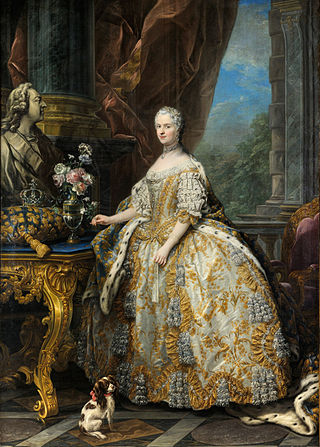
Maria Karolina Zofia Felicja Leszczyńska, also known as Marie Leczinska, was Queen of France as the wife of King Louis XV from their marriage on 4 September 1725 until her death in 1768. The daughter of Stanisław Leszczyński, the deposed King of Poland, and Catherine Opalińska, her 42-years and 9 months service was the longest of any queen in French history. A devout Roman Catholic throughout her life, Marie was popular among the French people for her numerous charitable works and introduced many Polish customs to the royal court at Versailles. She is also one of the popularizers of the hurdy gurdy in the court of Louis XV, she played the instrument herself and made the gurdy famous. She was the grandmother of the French kings Louis XVI, Louis XVIII and Charles X.

Frederica of Baden was Queen of Sweden from 1797 to 1809 as the consort of King Gustav IV Adolf.

Anne Louise Bénédicte de Bourbon was the daughter of Henri Jules de Bourbon, Prince of Condé, and Anne Henriette of Bavaria. As a member of the reigning House of Bourbon, she was a princesse du sang. Forced to marry the Duke of Maine, legitimised son of Louis XIV and Madame de Montespan, she revelled in politics and the arts, and held a popular salon at the Hôtel du Maine as well as at the Château de Sceaux.

Louis Antoine de Bourbon, Duke of Enghien was a member of the House of Bourbon of France. More famous for his death than his life, he was executed on charges of aiding Britain and plotting against France, shocking royalty across Europe.

Louis Henri Joseph de Bourbon was the Prince of Condé from 1818 to his death. He was the brother-in-law of Philippe Égalité and nephew of Victoire de Rohan.
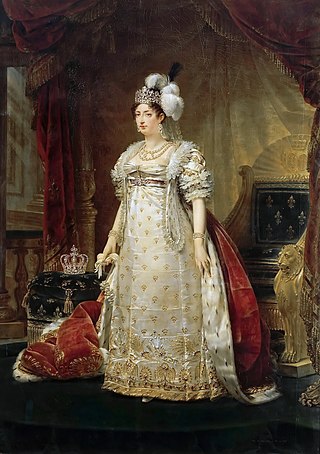
Marie-Thérèse Charlotte was the eldest child of King Louis XVI and Queen Marie Antoinette of France. In 1799 she married her cousin Louis Antoine, Duke of Angoulême, the eldest son of Charles, Count of Artois, henceforth becoming the Duchess of Angoulême. She was briefly disputed Queen of France in 1830. Marie-Thérése was the only child of her parents to reach adulthood.

Sophie Dawes, Baroness de Feuchères by marriage, was an English "adventuress" best known as a mistress of Louis Henry II, Prince of Condé.
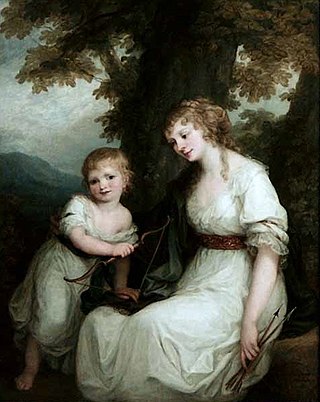
Beate Barbara Juliane Freifrau von Krüdener, often called by her formal French name, Madame de Krüdener, was a Baltic German religious mystic, author, and Pietist Lutheran theologian who exerted influence on wider European Protestantism, including the Swiss Reformed Church and the Moravian Church, and whose ideas influenced Tsar Alexander I of Russia.

Marie Joséphine of Savoy was a princess of France and Countess of Provence by marriage to the future King Louis XVIII of France. She was regarded by Bourbon Royalist Legitimists as the titular 'queen of France' when her husband assumed the title of king in 1795 upon the death of his nephew, the titular King Louis XVII of France, until her death. She was never practically queen, as she died before her husband actually became king in 1814.
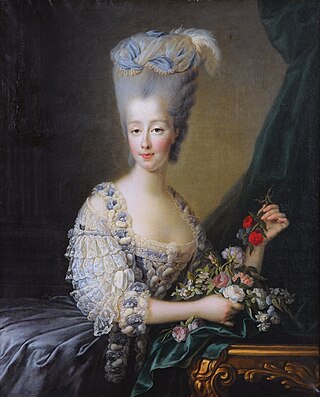
Maria Theresa of Savoy was a French princess by marriage to Charles Philippe, Count of Artois; he being the grandson of Louis XV of France, and younger brother of the future Louis XVI of France. Nineteen years after Maria Theresa’s death, her spouse assumed the throne of France as King Charles X. Her son, Prince Louis Antoine, married Marie Antoinette’s daughter Marie-Thérèse Charlotte, they being the King and Queen of France for approximately 20 minutes on 2 August 1830.

Bathilde d'Orléans was a French princess of the blood of the House of Orléans. She was sister of Philippe Égalité, the mother of the Duke of Enghien and aunt of Louis Philippe I, King of the French. Married to the young Duke of Enghien, a distant cousin, she was known as the Duchess of Bourbon following the birth of her son. She was known as Citoyenne Vérité during the French Revolution.

Fredrika Charlotte "Lolotte" Forssberg (1766–1840) was a Swedish noble and lady-in-waiting, later countess Stenbock. She was one of the most talked about people of her time as the possible child of King Adolf Frederick of Sweden. Princess Sophia Albertina of Sweden investigated her birth in the 1790s and tried to have her acknowledged as the daughter of her father. The truth is unconfirmed, though it is considered likely that she was the illegitimate daughter of the king.

Louise Antoinette Lannes, Duchess of Montebello was a French courtier, dame d'honneur to Empress Marie Louise of France, and the second wife of Jean Lannes, one of Napoléon's ablest Marshals, who was nicknamed the Roland of the Grand Armée.. She was the daughter of senator and financier François Scholastique, Count of Guéhéneuc. She was the sister of general Charles Louis Joseph Olivier, Count of Guéhéneuc.
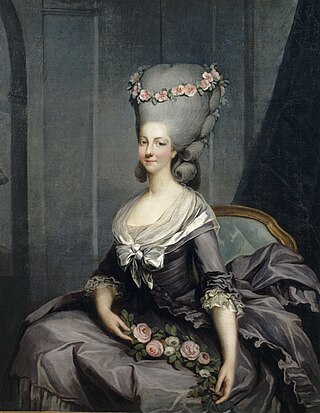
Marie Thérèse Louise was a member of the Savoy-Carignano cadet branch of the House of Savoy. She was married at the age of 17 to Louis Alexandre de Bourbon-Penthièvre, Prince de Lamballe, the heir to the greatest fortune in France. After her marriage, which lasted a year, she went to the French royal court and became the confidante of Queen Marie Antoinette. She was killed in the massacres of September 1792 during the French Revolution.
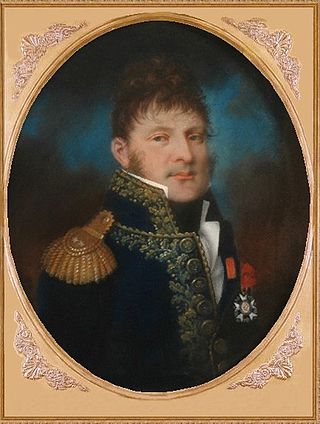
Pierre-Augustin Hulin was a French general under Napoleon Bonaparte who took part in the storming of the Bastille, the trial of the Duke d'Enghien, and the foiling of the Malet coup.

Marie-Éléonore Godefroid, was a French painter, watercolorist, pastellist, and draughtswoman. Some of her major works include Portraits of the Children of Marshall Duke d'Enghien (1810), Portrait of Queen Hortense with her Children (1812), the Royal Princes, Portrait of the Princesses Louise and Marie d'Orléans, and Portrait of the Prince de Joinville. Godefroid is best known as a portrait painter.
References
- Wilhelmina Stålberg (in Swedish): Anteqningar om Svenska kvinnor (Notes on Swedish women)
- Bernt Von Schinkel (in Swedish) : Minnen Ur Sveriges Nyare Historia (Memoires from the earlier history of Sweden)